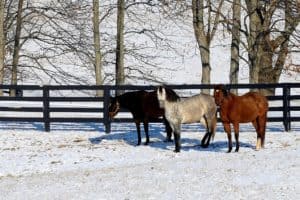
Is Rained-On Hay Any Good for Horses?
Learn about how rain during harvesting can affect hay quality and whether you should feed rained-on hay to your horses.

Learn about how rain during harvesting can affect hay quality and whether you should feed rained-on hay to your horses.

Acute respiratory distress syndrome (ARDS) causes rapidly progressive and severe respiratory failure and is associated with high mortality in affected patients.

The 2019 outbreak of VSV was the largest in recent history with 1,144 premises affected in eight states: Colorado, Kansas, Nebraska, New Mexico, Oklahoma, Texas, Utah, and Wyoming.

A farrier is part of a team that also includes the horse, owner, trainer, grooms, and veterinarian. This team approach is never more necessary than when a horse has an injury or disease.

With the national horse population trending down, the abundance of options available to horse buyers has left some rare breeds teetering on the edge of catastrophic loss.
Guttural pouch mycosis (GPM) is a potentially life-threatening disease that may initially present as a simple nosebleed (epistaxis) or even poor performance in an equine athlete.

Clostridial myositis is a rare but serious bacterial infection, which causes inflammation and death of muscle and release of bacterial toxins into the bloodstream.

Current horse breeding trends are characterized by a decline in mares bred and a new focus on well-being of established pregnancies, as well as enhanced genetic selection related to the health and future performance of foals.

Learn which mosquitoes can transmit disease and how to manage populations on your farm.

Sarcoids are believed to be the most common equine skin tumor, affecting about 2% of the worldwide population. Here’s what you need to know about these potentially problematic skin growths.

Equine influenza virus activity has increased in the U.S. and Europe recently. Here’s what you can do to protect your horse.

Reported diseases included African horse sickness, atypical myopathy, contagious equine metritis, salmonellosis, and more.

Commonly called Potomac horse fever (PHF), equine neorickettsiosis can result in fever, colic of variable severity, diarrhea, abortion, and other clinical signs.

Appropriate use of vaccination and implementing biosecurity measures are critical to protecting the horse industry from outbreaks of highly contagious viruses, including equine influenza.

It’s critical that owners and breeding farms send aborted foals to a veterinary diagnostic laboratory, even if the cause of abortion appears obvious. Here’s why.

Plan ahead to keep family, employees, and horses safe during a winter weather disaster.
Stay on top of the most recent Horse Health news with